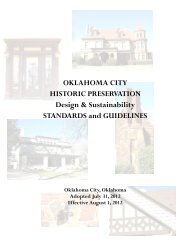OKC Plan, 2000-2020 - City of Oklahoma City
OKC Plan, 2000-2020 - City of Oklahoma City
OKC Plan, 2000-2020 - City of Oklahoma City
You also want an ePaper? Increase the reach of your titles
YUMPU automatically turns print PDFs into web optimized ePapers that Google loves.
Appreciation <strong>of</strong> Historical Resources<br />
Story telling is one <strong>of</strong> the significant cultural functions <strong>of</strong> any society. In contrast to constructing<br />
memorials intended to honor persons or events, preserving significant features <strong>of</strong> the structures and<br />
areas where history-changing events occurred keeps our stories alive, giving them a context,<br />
confirming their value and clarifying their relevance. Physical evidence <strong>of</strong> the past keeps these<br />
stories accurate and allows us to re-evaluate events from our diverse and changing perspectives.<br />
By giving ourselves and future generations opportunities to experience those stories in place, we<br />
provide a solid, positive image <strong>of</strong> who we are. Perhaps as important, we provide a place for healing<br />
the wounds <strong>of</strong> history as well. Historic preservation gives a sense <strong>of</strong> maturity within a context <strong>of</strong><br />
change.<br />
One <strong>of</strong> the first steps in any preservation program is to identify historic properties. Historians work<br />
with community groups to examine the historic significance <strong>of</strong> a property, based on established<br />
criteria. This historic information is used in the evaluation <strong>of</strong> the historic integrity <strong>of</strong> a property.<br />
Historic integrity refers to the ability <strong>of</strong> a historic property to convey its significance. For example,<br />
a Craftsman bungalow that has been severely renovated with new features from a different historic<br />
period would no longer be an authentic example <strong>of</strong> the original architectural style, and therefore, the<br />
property would have lost its historic integrity. This process <strong>of</strong> identifying and evaluating properties<br />
is the basis for recording our stories and preserving the fabric that verifies them.<br />
Directions<br />
Continue <strong>Oklahoma</strong> <strong>City</strong>’s participation in the State Historic Preservation Office’s<br />
Certified Local Governments (CLG) Program.<br />
Document and designate <strong>Oklahoma</strong> <strong>City</strong>’s architectural heritage.<br />
Preserve <strong>Oklahoma</strong> <strong>City</strong>’s stories, telling these stories in exciting ways that promote interest in<br />
them and make them accessible.<br />
Actions<br />
Identify buildings, places, and structures <strong>of</strong> historical or architectural significance for historical<br />
designation and documentation.<br />
Work with citizens and preservation pr<strong>of</strong>essionals to identify culturally and historically<br />
significant properties that are endangered.<br />
Give immediate attention to the historic designation and documentation <strong>of</strong> key buildings<br />
warranting preservation. Reevaluate priorities on an annual basis.<br />
72

















